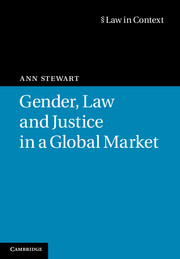Book contents
- Frontmatter
- Contents
- Figures
- Acknowledgements
- Abbreviations
- Introduction Living in a Global North consumer society
- 1 Constructing relationships in a global economy
- 2 Globalising feminist legal theory
- 3 State, market and family in a Global North consumer society
- 4 Gender justice in Africa
- 5 From anonymity to attribution
- 6 Constructing body work
- 7 Global body work markets
- 8 Constructing South Asian womanhood through law
- 9 Trading and contesting belonging in multicultural Britain
- Conclusion
- References
- Index
Introduction - Living in a Global North consumer society
a contextual vignette
Published online by Cambridge University Press: 05 June 2012
- Frontmatter
- Contents
- Figures
- Acknowledgements
- Abbreviations
- Introduction Living in a Global North consumer society
- 1 Constructing relationships in a global economy
- 2 Globalising feminist legal theory
- 3 State, market and family in a Global North consumer society
- 4 Gender justice in Africa
- 5 From anonymity to attribution
- 6 Constructing body work
- 7 Global body work markets
- 8 Constructing South Asian womanhood through law
- 9 Trading and contesting belonging in multicultural Britain
- Conclusion
- References
- Index
Summary
I live in an inner city neighbourhood in the United Kingdom (UK). When I visit the well women’s clinic, at a surgery where all the doctors are practising Christians, I sit next to a middle-aged Somalian Muslim woman. We live on the same street, share a lawn mower, and struggle to grow plants under large trees. I know that she will probably be circumcised because I am familiar with the statistics – a 95 per cent prevalence rate for women in Somalia (UNICEF 2004). She laughs, and expresses incomprehension, when, as a middle-aged woman, I run along the street, sweating profusely and clad in very little.
Behind my house, a group of boys aged between seven and fifteen regularly play football. They argue vociferously about the rules in fluent ‘street’ English. Many are Somalis by origin although there are white and African Caribbean boys as well. Their sisters emerge to congregate around the public bench to chat and occasionally to play ball games but always on the margins of the ‘pitch’. On Saturday mornings I see the boys returning from their classes in the Koran while one white young man delivers newspapers to my door. His father used to clean our windows until he had a bad accident. He now works for a landscape garden firm but the work is precarious and does not provide an adequate income, so his wife has started to work part time as a social carer for a local disabled adult. His daughter and her female partner look through household items in my cellar which used to belong to my parents to see whether anything would be useful for their flat because they are setting up home together.
- Type
- Chapter
- Information
- Gender, Law and Justice in a Global Market , pp. 1 - 9Publisher: Cambridge University PressPrint publication year: 2011



